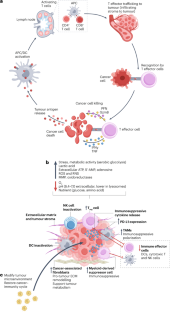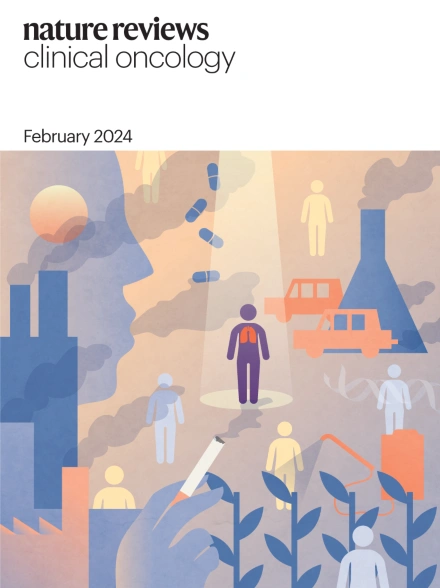Enhancing immunotherapy with tumour-responsive nanomaterials
IF 82.2
1区 医学
Q1 ONCOLOGY
引用次数: 0
Abstract
The targeted delivery of immunotherapies to tumours using tumour-responsive nanomaterials is a promising area of cancer research with the potential to address the limitations of systemic administration such as on-target off-tumour toxicities and a lack of activity owing to the immunosuppressive tumour microenvironment (TME). Attempts to address these challenges include the design and functionalization of nanomaterials capable of releasing their cargoes in response to specific TME characteristics, thus facilitating the targeted delivery of immune-checkpoint inhibitors, cytokines, mRNAs, vaccines and, potentially, chimaeric antigen receptors as well as of agents that modulate the extracellular matrix and induce immunogenic cell death. In this Review, we describe these various research efforts in the context of the dynamic properties of the TME, such as pH, reductive conditions, reactive oxygen species, hypoxia, specific enzymes, high levels of ATP and locoregional aspects, which can be leveraged to enhance the specificity and efficacy of nanomaterial-based immunotherapies. Highlighting preclinical successes and ongoing clinical trials, we evaluate the current landscape and potential of these innovative approaches. We also consider future research directions as well as the most important barriers to successful clinical translation, emphasizing the transformative potential of tumour-responsive nanomaterials in overcoming the barriers that limit the activity of traditional immunotherapies, thus improving patient outcomes. Immunotherapies, predominantly immune-checkpoint inhibitors and chimaeric antigen receptor T cells, have transformed oncology. Nonetheless, these systemically administered agents have several limitations, including the risk of off-target toxicities and a lack of activity owing to an inability to overcome an immunosuppressive tumour microenvironment (TME). In this Review, the authors describe the potential to overcome these challenges using functionalized nanomaterials that are designed to release a wide range of immunotherapeutic cargoes in response to specific TME characteristics, including hypoxia, differences in pH, the presence of specific enzymes, reactive oxygen species and/or high levels of extracellular ATP.


肿瘤反应性纳米材料增强免疫治疗
利用肿瘤反应性纳米材料将免疫疗法靶向递送到肿瘤是癌症研究的一个有前景的领域,有可能解决全身给药的局限性,如靶外肿瘤毒性和由于免疫抑制肿瘤微环境(TME)而缺乏活性。解决这些挑战的尝试包括设计和功能化纳米材料,使其能够根据特定的TME特征释放其载物,从而促进免疫检查点抑制剂、细胞因子、mrna、疫苗和潜在的嵌合抗原受体的靶向递送,以及调节细胞外基质和诱导免疫原性细胞死亡的药物。在这篇综述中,我们在TME的动态特性的背景下描述了这些不同的研究成果,如pH值、还原条件、活性氧、缺氧、特定酶、高水平ATP和局部区域方面,这些可以用来提高纳米材料免疫疗法的特异性和有效性。强调临床前成功和正在进行的临床试验,我们评估了这些创新方法的现状和潜力。我们还考虑了未来的研究方向以及成功临床转化的最重要障碍,强调肿瘤反应纳米材料在克服限制传统免疫疗法活性的障碍方面的转化潜力,从而改善患者的预后。
本文章由计算机程序翻译,如有差异,请以英文原文为准。
求助全文
约1分钟内获得全文
求助全文
来源期刊
CiteScore
99.40
自引率
0.40%
发文量
114
审稿时长
6-12 weeks
期刊介绍:
Nature Reviews publishes clinical content authored by internationally renowned clinical academics and researchers, catering to readers in the medical sciences at postgraduate levels and beyond. Although targeted at practicing doctors, researchers, and academics within specific specialties, the aim is to ensure accessibility for readers across various medical disciplines. The journal features in-depth Reviews offering authoritative and current information, contextualizing topics within the history and development of a field. Perspectives, News & Views articles, and the Research Highlights section provide topical discussions, opinions, and filtered primary research from diverse medical journals.

 求助内容:
求助内容: 应助结果提醒方式:
应助结果提醒方式:


